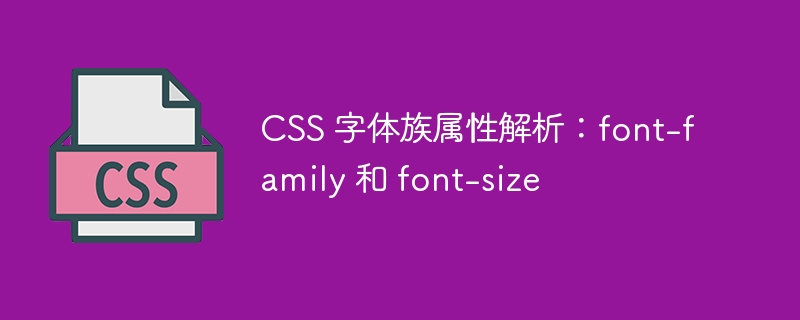Home >Web Front-end >CSS Tutorial >CSS font family property analysis: font-family and font-size
CSS font family property analysis: font-family and font-size
- WBOYWBOYWBOYWBOYWBOYWBOYWBOYWBOYWBOYWBOYWBOYWBOYWBOriginal
- 2023-10-21 11:27:201132browse

CSS font family attribute analysis: font-family and font-size
In web design, the selection and size of fonts are very important, they directly affect The readability and overall style of the web page. CSS provides a wealth of font properties, the most commonly used of which include font-family and font-size.
- font-family property
font-family is used to specify the name of the font or the priority order of the font family. For example, we can set the font as follows:
p {
font-family: Arial, Helvetica, sans-serif;
}In this example, the Arial font will be tried first. If the Arial font is not available, the Helvetica font will be tried. Finally, if the Helvetica font is not available, then the Use the default sans-serif font. This way of setting up a font family is very useful because the same fonts may not be available on different devices.
In CSS, font-family can also specify a list containing multiple font names, as follows:
h1 {
font-family: "Times New Roman", Times, serif;
}In this example, if the Times New Roman font is not available on the user's device, Times font will be tried, and if Times font is not available, the default serif font will be used.
Additionally, there are some universal font families that can be used across different operating systems and browsers, such as sans-serif, serif, monospace, cursive, and fantasy.
- font-size attribute
font-size is used to specify the size of the font. Common units include pixels (px), percentages (%), and em.
h2 {
font-size: 24px;
}In this example, the font size of the h2 element is set to 24 pixels.
In addition, we can also use percentage units to specify the font size, for example:
h3 {
font-size: 120%;
}In this example, the font size of the h3 element is 120% of the font size of the parent element.
Finally, you can also specify the font size using em units, which are calculated relative to the font size of the element itself. For example:
p {
font-size: 1.2em;
}In this example, the font size of the p element is 1.2 times the font size of the parent element.
Summary
In web design, it is very important to correctly choose the appropriate font and size. The priority order of fonts can be set through the font-family attribute to ensure good display effects on different devices. The font-size property is used to adjust the size of the font, which can be specified in pixels, percentages, and em units. By using these two attributes properly, you can make the fonts on the web page more beautiful and easier to read.
The above is the detailed content of CSS font family property analysis: font-family and font-size. For more information, please follow other related articles on the PHP Chinese website!

